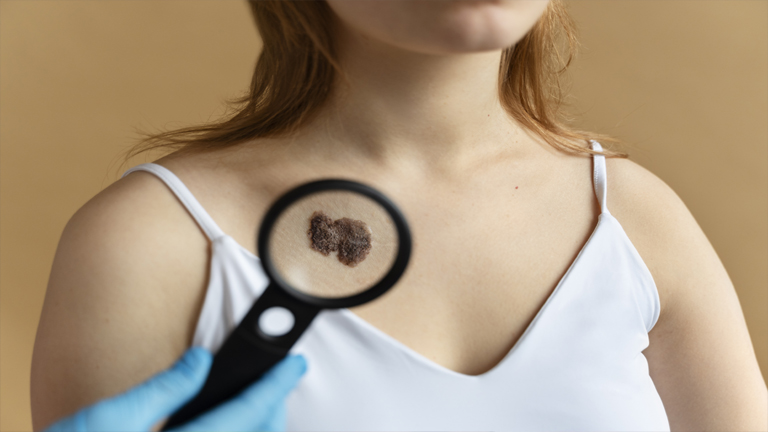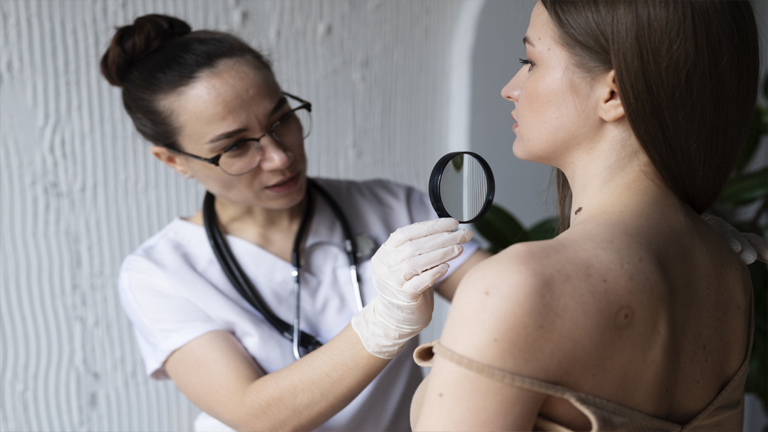Skin cancer is one of the most common types of cancer worldwide, affecting millions of people each year. It occurs when abnormal skin cells grow uncontrollably, often due to excessive exposure to ultraviolet (UV) radiation from the sun or tanning beds. Early detection and treatment are crucial for improving survival rates.
In this comprehensive guide, we’ll explore the types of skin cancer, symptoms, risk factors, diagnosis, treatment options, and prevention strategies to help you stay informed and protected.
Must Check: Top Glowing Skin
What Is Skin Cancer?
Skin cancer develops when mutations occur in the DNA of skin cells, leading to uncontrolled growth. The three main types are:
-
Basal Cell Carcinoma (BCC) – The most common and least aggressive form.
-
Squamous Cell Carcinoma (SCC) – More likely to spread than BCC but highly treatable when caught early.
-
Melanoma – The most dangerous type, with a higher risk of spreading to other organs.
Other rare forms include Merkel cell carcinoma and cutaneous lymphoma.
Causes and Risk Factors of Skin Cancer
Several factors contribute to the development of skin cancer, including:
1. UV Radiation Exposure
-
Sun exposure – Prolonged, unprotected exposure increases risk.
-
Tanning beds – Artificial UV rays are just as harmful as natural sunlight.
2. Skin Type and Genetics
-
Fair-skinned individuals with light hair and eyes are at higher risk.
-
A family history of skin cancer increases susceptibility.
3. Moles and Precancerous Lesions
-
Atypical moles (dysplastic nevi) can develop into melanoma.
-
Actinic keratosis (rough, scaly patches) may progress to SCC.
4. Weakened Immune System
-
Organ transplant recipients and HIV/AIDS patients have a higher risk.
5. Environmental and Occupational Hazards
-
Exposure to arsenic, coal tar, and certain chemicals can increase risk.
Signs and Symptoms of Skin Cancer
Recognizing early warning signs can save lives. Look for:
Basal Cell Carcinoma (BCC) Symptoms
-
Pearly or waxy bump
-
Flat, flesh-colored or brown scar-like lesion
-
Bleeding or scabbing sore that heals and returns
Squamous Cell Carcinoma (SCC) Symptoms
-
Red, firm nodule
-
Flat lesion with a scaly, crusted surface
-
Slow-healing ulcer
Melanoma Warning Signs (ABCDE Rule)
-
Asymmetry – Irregularly shaped moles
-
Border – Uneven or blurred edges
-
Color – Multiple colors (black, brown, red, white, blue)
-
Diameter – Larger than 6mm (pencil eraser size)
-
Evolving – Changing in size, shape, or texture
Diagnosis and Staging of Skin Cancer
If a suspicious lesion is found, a dermatologist may perform:
1. Skin Biopsy
-
Shave biopsy – Removal of the top layers of skin.
-
Punch biopsy – A small, circular tool extracts deeper skin layers.
-
Excisional biopsy – Entire lesion removal for testing.
2. Imaging Tests (For Advanced Cases)
-
CT scan, MRI, or PET scan to check for metastasis.
3. Staging (Melanoma and Aggressive Cancers)
-
Stage 0 (In situ) – Cancer is only in the outer skin layer.
-
Stage I & II – Localized but may be thicker.
-
Stage III – Spread to nearby lymph nodes.
-
Stage IV – Metastasized to distant organs.
Skin Cancer Types, Symptoms, and Treatments
| Type of Skin Cancer | Common Symptoms | Primary Treatment Options | Risk Factors |
|---|---|---|---|
| Basal Cell Carcinoma (BCC) | – Pearly or waxy bump – Flat, flesh-colored lesion – Bleeding sore that heals & returns |
– Surgical excision – Mohs surgery – Cryotherapy – Topical treatments (imiquimod) |
– Fair skin – Chronic sun exposure – History of sunburns |
| Squamous Cell Carcinoma (SCC) | – Red, firm nodule – Scaly, crusted lesion – Non-healing ulcer |
– Surgical removal – Radiation therapy – Electrodessication & curettage |
– UV exposure (sun/tanning beds) – Weakened immune system – HPV infection |
| Melanoma | – Asymmetrical mole – Irregular borders – Multiple colors – Growing lesion |
– Wide excision – Lymph node biopsy – Immunotherapy (Keytruda, Opdivo) – Targeted therapy |
– Family history – Many moles – Severe sunburns in childhood |
| Merkel Cell Carcinoma | – Fast-growing, painless nodule (red/purple) – Shiny, firm appearance |
– Surgery – Radiation – Immunotherapy (avelumab) |
– Sun exposure – Merkel cell polyomavirus – Older age (>50) |
| Actinic Keratosis (Precancerous) | – Rough, scaly patches – Itching/burning sensation |
– Cryotherapy – Topical chemotherapy (5-FU) – Photodynamic therapy (PDT) |
– Chronic sun damage – Fair skin type |
Treatment Options for Skin Cancer
Treatment depends on the type, stage, and location of cancer.
1. Surgical Treatments
-
Excision – Cutting out the tumor and surrounding tissue.
-
Mohs Surgery – Layer-by-layer removal for precision (common for BCC and SCC).
-
Lymph Node Dissection – If cancer has spread to lymph nodes.
2. Non-Surgical Treatments
-
Radiation Therapy – For patients who can’t undergo surgery.
-
Chemotherapy – Topical creams (for early cancers) or systemic drugs (for advanced cases).
-
Immunotherapy – Boosts the immune system to fight cancer (e.g., Keytruda for melanoma).
-
Targeted Therapy – Attacks specific genetic mutations in cancer cells.
3. Emerging Treatments
-
Photodynamic Therapy (PDT) – Uses light-activated drugs to destroy cancer cells.
-
Cryotherapy – Freezing precancerous lesions.
Prevention: How to Reduce Skin Cancer Risk
1. Sun Protection Strategies Skin Cancer
-
Use broad-spectrum SPF 30+ sunscreen daily.
-
Wear protective clothing, hats, and UV-blocking sunglasses.
-
Seek shade between 10 AM – 4 PM when UV rays are strongest.
2. Avoid Tanning Beds Skin Cancer
-
Artificial UV exposure increases melanoma risk by 75%.
3. Regular Skin Checks Skin Cancer
-
Perform monthly self-exams using a mirror.
-
Visit a dermatologist annually for professional skin exams.
4. Vitamin D and Diet
-
Get vitamin D safely through diet (fatty fish, fortified foods) rather than excessive sun exposure.
When to See a Doctor
Consult a dermatologist if you notice:
✅ A new, changing, or unusual mole
✅ A sore that doesn’t heal
✅ A spot that bleeds, itches, or crusts
Early detection saves lives—don’t delay!
Conclusion
Skin cancer is highly preventable and treatable when caught early. By understanding the causes, symptoms, and prevention methods, you can take proactive steps to protect yourself and your loved ones. Regular skin checks, sun protection, and avoiding tanning beds are key to reducing risk.
If you suspect any unusual changes in your skin, schedule an appointment with a dermatologist immediately. Stay informed, stay protected, and prioritize your skin health!
FAQs About Skin Cancer
Q: Can dark-skinned people get skin cancer?
A: Yes, though less common, melanoma can be more aggressive in darker skin tones.
Q: How often should I check my skin?
A: Perform self-exams monthly and see a dermatologist yearly.
Q: Is sunscreen necessary on cloudy days?
A: Yes! Up to 80% of UV rays penetrate clouds.
Q: Can skin cancer come back after treatment?
A: Yes, regular follow-ups are essential to monitor recurrence.
By following this guide, you can stay ahead in the fight against skin cancer. Share this article to spread awareness!


